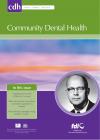Community Dental Health

- Cover Date:
- March 2010
- Print ISSN:
- 0265 539X
- Vol:
- 27
- Issue:
- 1
Are paediatric medicines risk factors for dental caries and dental erosion?
The objective: To assess in vitro the cariogenic and erosive potentials of Brazilian liquid oral paediatric medicines. Setting: Twenty-three paediatric medicines available on the Brazilian market were evaluated. The sample consisted of antihistamines, antitussives, bronchodilators and mucolytics. Main outcome measures: Duplicates of each bottle were analyzed for sugar concentration using normal-phase- high-performance liquid chromatography (HPLC). Quantification of sugars and sorbitol was calculated using the peak heights of commercial standards as references. pH measurements were determined using a digital pH meter. Titratable acidity was assessed by diluting three aliquots of each medicine, and increments of 0.1N NaOH were titrated until neutrality was reached. Viscosity was determined using a viscosemeter. Results: Sugars were detected in 56.5% of the medicines. Sucrose was identified in 10 medicines, with concentrations ranging from 11.36 g% to 85.99 g%. Glucose was detected in five medicines, with concentrations varying from 4.64 g% to 40.19 g%; fructose in six medicines, with concentrations ranging from 5.09 g% to 46.71 g%. Twelve medicines exhibited sorbitol, with values ranging from 5.39 g% to 46.09 g%. Most tested medicines were acidic, with pH values ranging between 2.6 and 5.7. Only two medicines (Fluimucil and Polaramine) presented pH 6.4 and 6.0, respectively. Titratable acidity mean values ranged between 0.28 and 16.33 mL. Viscosity values varied between 2.8 cP and 412.3 cP. Conclusions: Many paediatric medicines showed high sugar concentration, pH values below the critical value and high titratable acidity values, all of which increase the medicines’ cariogenic and erosive potentials. Key words: Acidity, dental caries, pharmaceutical preparations, sweetening agents, tooth erosion, viscosity,
Introduction
The ideal drug for children should be effective, economical, well tolerated, and palatable (Pawar and Kumar, 2002). Because of the bitter taste of most drugs, sugar is combined with other ingredients to provide palatable dosages forms, thus ensuring patient compliance, especially for paediatric use. In addition to sweetness, sugar provides desirable functional properties, such as acting indirectly as antioxidant, solvent, demulcent and bulking agent (Bigeard, 2000). The long-term use of liquid oral medicines may contribute to dental caries, as shown by clinical studies (Roberts and Roberts, 1979; Sahgal et al., 2002) and plaque pH studies (Mentes, 2001; Rekola, 1989). Acids are also commonly used in medicines as buffering agents to maintain chemical stability, improve flavor and to control tonicity (Maguire et al., 2007). The regular and frequent use of acidic medicines coming in direct contact with teeth has been identified as an etiological factor in dental erosion (Costa et al., 2006; Hellwig and Lussi, 2006; Linnet and Seow, 2001). Other factors related to paediatric medicines might also contribute to the risk of dental caries and erosion, for example, high frequency of ingestion, bedtime consumption, reduced salivary flow caused by the use of
some drugs and high viscosity (implying longer contact time with tooth surface) (Linnet and Seow, 2001; Lussi et al., 2004; Maguire et al., 2007). This problem especially concerns chronically sick children, who require long-term medication (Costa et al., 2006; Roberts and Roberts, 1979), and children who receive medications frequently because of various recurrent benign pathologies, such as coughs and colds (Bigeard, 2000). Although a public-health policy to limit sugar in medicines has been implemented in several developed countries such as Great Britain, the United States, Canada and Australia (Bigeard, 2000; Maguire and Rugg-Gunn, 1997), some developing countries (e.g., Brazil) do not have a policy for the use of paediatric medicines especially because of the lack of information on their sugar content and acidity (Neiva et al., 2001). Therefore, the aim of this study was to assess the cariogenic and erosive potentials of Brazilian oral liquid paediatric medicines by determining their sugar content, pH, titratable acidity and viscosity.
Method
Twenty-three samples of liquid paediatric medicines from different brands available on the Brazilian market were selected from the list of the “reference medicines†of the
Correspondence to: Dr. Lucianne Cople Maia, Rua Gastão Gonçalves 47 apto. 501 – Santa Rosa, Niterói-RJ-Brasil, CEP: 24240-030. E-mail: rorefa@terra.com.br
- Article Price
- £15.00
- Institution Article Price
- £
- Page Start
- 46
- Page End
- 51
- Authors
- B.G. Neves, A. Farah, E. Lucas, V.P. de Sousa, L.C. Maia
Articles from this issue
- Title
- Pg. Start
- Pg. End
- The influence of economic incentives on treatment patterns in a third-party funded dental service
- 18
- 22
- Is tooth wear in the primary dentition predictive of tooth wear in the permanent dentition? Report from a longitudinal study.
- 41
- 45
- Chewing stick use among African immigrants in West Philadelphia: implications for oral health providers
- 60
- 64
